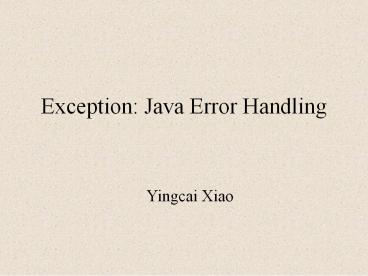Exception: Java Error Handling PowerPoint PPT Presentation
Title: Exception: Java Error Handling
1
Exception Java Error Handling
- Yingcai Xiao
2
- Error Handling
- In-line
- if(error) System.out.println(Error occurred
here.) - Block-based
- if(error)
- ErrorCode ErrorTypeOne
- goto ErrorHandlingBlock
- ErrorHandlingBlock
- switch(ErrorCode)
- case ErrorTypeOne
- break
3
- Error Handling
- Function-based
- if(error) ErrorHandlingFunction(ErrorCode)
- Event-based Object-oriented
- An event is generated when an error occurs.
Event handling functions are error handling
functions registered to handle error events. - In Java, an error event is called an exception.
Error handling functions are called exception
handlers. An object that describes an error is
called an exception object. - An exception is an unexpected condition
preventing the normal execution of the code. - Note some errors are expected conditions. For
example, the user gives an out-of-range input.
4
- Exception Based Error Handling
- Create an exception object when an error
condition occurs. - throw the exception object.
- Current path of execution is stopped.
- (done by the Java Interpreter)
- Execution jumps to a registered exception
handler (the nearest one and go no further).
(done by the Java Interpreter) - The event handler handles the error and
determines the path of continuation. - e.g.
- MyObject o new MyObject()
- if(o null) throw new NullPointerException()
5
- Exception Based Error Handling
- Note
- Exceptions can be throwed anywhere in the code.
- Exception handlers can be defined anywhere as
needed. - Low level library methods may throw exceptions
but expecting the methods users to handle the
exceptions. - Standard Java exceptions can be found at
java.sun.com. - When overriding a method, you can throw only the
exceptions that have been specified in the
base-class version of the method.
6
- Try and Catch
- The try block
- a guarded code region that may produce
exceptions - The method hosting the try block will exit upon
the throwing of an exception, unless the
exception is caught by a catch block right
after the try block.
7
- Try and Catch
try // Code that might generate exceptions
// Dont create objects here if they are to be
used elsewhere. catch(Type1 id1) // Handle
exceptions of Type1 catch(Type2 id2) //
Handle exceptions of Type2 catch(Type3 id3)
// Handle exceptions of Type3
8
- Creating a New Exception Class
// define a new exception class by subclassing //
from the Exception class class SimpleException
extends Exception public class
SimpleExceptionDemo // Any exceptions to be
thrown out should be // listed in the function
header public void f() throws SimpleException
System.out.println( "Throwing
SimpleException from f()") throw new
SimpleException ()
9
- Using a New Exception Class
public static void main(String args)
SimpleExceptionDemo sed new
SimpleExceptionDemo() try sed.f()
// exceptions thrown out from f
catch(SimpleException e)
System.err.println("Caught it!")
///
10
- Some Methods in the Exception Class
Exception is a child of throwable, which in turn
is a child of Object. String getMessage( )String
getLocalizedMessage( )String toString( )void
printStackTrace( ) void printStackTrace(PrintStre
am)void printStackTrace(PrintWriter) Class
getClass( )
11
- Rethrowing an Exception
Rethrowing an exception causes the exception to
go to the exception handlers in the next-higher
context. catch(Exception e)
System.err.println("An exception was thrown")
throw e
12
- Performing cleanup with finally
try // The guarded region Dangerous
activities // that might throw A, B, or C
catch(A a1) // Handler for situation A
catch(B b1) // Handler for situation B
catch(C c1) // Handler for situation C
finally // Activities that happen every time
// regardless exceptions are thrown or not

